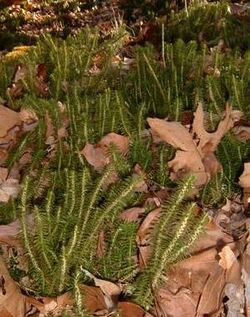Biology:Huperziaceae
| Huperziaceae (firmosses) | |
|---|---|

| |
| Shining firmoss, Huperzia lucidula | |
| Scientific classification | |
| Kingdom: | Plantae
|
| Division: | |
| Class: | |
| Order: | |
| Family: | Huperziaceae Rothm. 1962[1]
|
| Genera | |
The family Huperziaceae is one of two families sometimes recognized in the order Lycopodiales, and contains two or three extant genera:
- Huperzia (temperate firmosses); 10-15 species; terrestrial.
- Phlegmariurus (tropical firmosses); about 300-400 species; often included in Huperzia; mainly epiphytes.
- Phylloglossum (pygmy clubmoss); formerly thought to be only distantly related to Huperzia. This is a terrestrial, grass-like plant with basal, 2–5 cm long, fleshy leaves. The only listed species is Phylloglossum drummondii.
The genera of Huperziaceae are included in the family Lycopodiaceae in several classifications (in fact older classifications included the species of Huperzia within Lycopodium) and there is as yet no consensus as to whether Huperziaceae should be recognized as a distinct family. The plants are distinct from those of Lycopodiaceae s.s. in having erect (not creeping) growth; and in its spore-bearing structures being produced in the axils of unmodified leaves, unlike the terminal club-like structure produced by species in the Lycopodiaceae. The family also has a basal chromosome count of n=67, versus counts of n=23, 34 in the Lycopodiaceae.
References
External links
Wikidata ☰ Q2712709 entry

